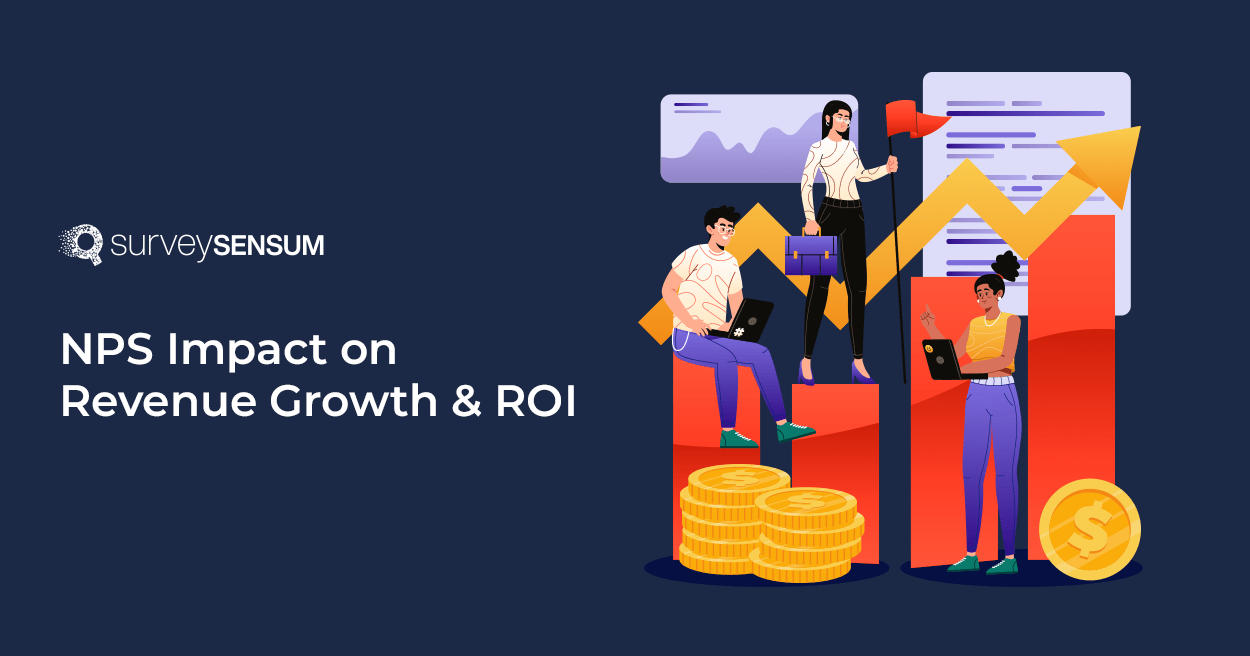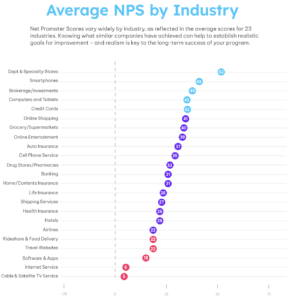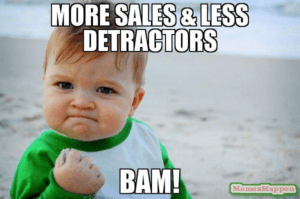9 Ways to Improve NPS Response Rates
Read More

In 2006, Bain & Company conducted thorough research on Dell’s detractors and promoters. They found that on average, a consumer is valued at $210 to Dell. However, a detractor ends up costing the company $57, while a satisfied promoter generates $328 in value.
Now, according to Bain & Company, if Dell could turn only 2-8% of those unhappy customers into satisfied ones, they could have boosted their annual revenue by $167 million. This demonstrates that by reducing customer churn and enhancing overall customer relationships, companies can save lost revenue and boost customer spending.
This small case study shows that when companies move beyond the traditional customer satisfaction metric and rigorously measure NPS, they can find ways to make customers happier, which, in turn, can lead to increased revenue.
NPS also helps companies identify areas where they might be making short-term gains at the expense of customer satisfaction, which could harm long-term profitability. And by focusing on improving NPS scores with an efficient NPS software, businesses can prioritize strategies that lead to sustainable growth.
Yet most businesses struggle to move beyond measuring their NPS. In other words, they may have a high or low NPS score but do not fully understand how this score directly impacts their revenue or overall business success.
So, the question here is how NPS impacts revenue growth and how businesses can actually leverage its potential to increase their revenue.
According to Bain & Company, in most industries, NPS Scores explain roughly 20% to 60% of the variation in organic growth rates among competitors. On average, an industry’s Net Promoter leader outgrew its competitors by a factor greater than two times.
In other words, a company’s NPS is a good indicator of its future growth. But the relationship is stronger in some industries than in others. This is why it is important to benchmark your NPS against competitors. These benchmarks can vary across industries due to differences in customer expectations and competitive dynamics.
To understand this difference better, the 2023 Satmetrix Net Promoter Benchmarks report (for US consumers) provides detailed information on the NPS score of 192 brands in 23 industry sectors, covering 63,939 respondents.

Now coming back to the topic of NPS impact on revenue. Here are some statistics to help you understand better.
In the early 2000s, Apple, known for its niche products, embarked on a journey of transformation. It started placing heavy importance on NPS, with every new employee receiving comprehensive training, including a specific focus on NPS. Regular NPS assessments and internal competition between Apple stores fueled performance improvements.
Between 2007 and 2011, Apple’s NPS soared from 58% to an impressive 72%. The investment paid off handsomely, with Apple generating a remarkable $6,000 in revenue per square meter of store space, while competitors averaged only $1,200. Apple’s success highlights the potent impact of NPS in elevating customer satisfaction and driving business growth.
Now we know that NPS has a significant impact on revenue and business growth. But the question remains – how can you leverage NPS to boost revenue for your business? Here are 4 ways to do that!

According to Nielsen, 92% of consumers around the world say they trust earned media, such as recommendations from friends and family.
This staggering number highlights that customers trust organic reviews which heavily influence their shopping decisions. So, why not leverage your promoters, aka your biggest fans, and convert them into your brand advocates?
Brand advocates are individuals who are passionate and loyal customers of your brand. They go beyond simply buying and using a product – they actively promote your brand to others willingly. They can be a valuable asset for businesses as they can help increase brand awareness, and build a positive reputation. .
So, it’s high time to take an extra step and convert your promoters into your brand advocates. Here’s how you can do that.
By effectively utilizing promoters as brand advocates, you can tap into the power of word-of-mouth marketing and create a network of loyal customers who not only bring in new business but also reinforce your brand’s positive image in the market.

A single negative review can sway around 40% of prospective buyers away from a product or service.
This highlights that getting negative reviews hurts A LOT for both brands and customers. Because potential customers often rely on these reviews as a source of authentic feedback from real users.
It’s not an exaggeration to say that negative online reviews can be a make-or-break factor for businesses.
Detractors are the customers who are not your biggest fans. Their dissatisfaction can quickly spread like wildfire through word-of-mouth, affecting not only their immediate network but potentially reaching a wider audience through social media.
That is why brands must stay vigilant in addressing detractors’ issues before they escalate into PR nightmares as we can see nowadays on social media platforms like Twitter.
Here’s how you can identify detractors and resolve issues in time:
Remember that the key is not just to address the individual detractor’s concerns but also to demonstrate your commitment to excellent customer service.
Explore SurveySensum To Get Automated Alerts On Detractors & Resolve Issues In Time

When customers churn, it directly leads to a loss in revenue. The revenue lost from a churned customer includes not only their initial purchases but also potential future purchases. And as we all know acquiring new customers costs 5-25 times more than retaining an existing one, depending on what industry you are in.
NPS can be a big help here. Measuring NPS can help companies identify detractors, understand the reasons for their dissatisfaction, implement strategies to improve customer satisfaction, and convert detractors into promoters.
Here’s how by focusing on NPS-driven initiatives, you can mitigate the financial consequences of customer churn and enhance long-term revenue prospects.
By focusing on NPS-driven initiatives, businesses can mitigate the financial consequences of customer churn and enhance long-term revenue prospects.
Another Customer Lost? Explore SurveySensum to Prevent Churn

NPS is not merely a one-time metric but a dynamic tool for continuous improvement.
Implementing NPS as an ongoing measurement process allows you to track changes in customer sentiment over time. This consistency provides a real-time pulse on customer satisfaction and loyalty.
In this journey of continuous improvement, it is important to understand the role of passives in driving incremental progress. They represent a significant opportunity for growth. By addressing their specific concerns, you can convert them into promoters. And eventually into your loyal customers.
Here are a few tips for using NPS as a tool for continuous improvement.
By measuring NPS consistently, leveraging passives’ insights, and nurturing promoters into advocates, organizations can create a virtuous cycle of enhanced customer satisfaction, loyalty, and revenue growth.
Now, that you know how to use NPS to boost revenue for your business, let’s talk about the latest and improved version of NPS – NPS 3.0.
Leverage NPS to Boost Your Revenue & ROI With SurveySensum
Fred Reichheld invented NPS almost 20 years ago in 2003 and since then it has been used by two-thirds of the Fortune 1000 companies. This customer satisfaction metric allows businesses to understand customer satisfaction beyond their improved financials by allowing them to understand how their work has improved customers’ lives.
However, over time, the credibility of NPS waned due to the misapplication of the metric. Some organizations started assessing their own NPS without directly surveying their customers or clients. This half-baked practice led to inaccuracies, misinterpretations, and a loss of benchmarking value.
To address these limitations, Fred Reichheld introduced a new concept called “Earned Growth” alongside NPS. He stumbled upon this idea during a First Bank executive conference, where he saw that most of the bank’s growth came from returning customers who also brought in friends and family. This observation invented the concept of “Earned Growth.”
Earned Growth is an accounting-based metric designed to complement NPS. It quantifies the direct financial benefits a company gains from customer loyalty and positive word-of-mouth referrals.
In the case of First Bank, Earned Growth proved its worth. Existing customers contributed to 50% of the growth in deposit balances, while referred customers accounted for another 32%. In essence, 82% of the bank’s deposit growth resulted from delivering exceptional customer experiences. Moreover, the bank’s loan growth outpaced industry standards, growing at 15% annually compared to the typical 2%-3% growth rate.
This demonstrates that Earned Growth isn’t just a measure of customer loyalty – it is a driver of long-term success and sustainable growth. By quantifying the revenue linked to customer loyalty and referrals, businesses gain a clearer understanding of the financial impact of their efforts to satisfy customers.
In summary, Earned Growth is a metric that transcends the measurement of customer loyalty alone. It underscores the pivotal role played by loyal customers and referrals in shaping a company’s long-term prosperity and success. Very well written
NPS is not just a metric but a strategic tool. By measuring NPS, businesses can not only improve their customer loyalty and satisfaction but it can also provide them with actionable insights that can drive their revenue and ROI.
However measuring NPS is not enough, businesses need to up their NPS game and complement it by calculating their earned growth rate. This approach helps businesses quantify their financial gain from customer loyalty and referral and help them to understand if their efforts are actually turning their customer into loyal customers – encouraging positive and organic referrals.
Use robust NPS software by SurveySensum to create effective NPS surveys, track thousands of customer feedback, analyze the NPS data, follow up with the detractors, and close the feedback loop in real-time.
